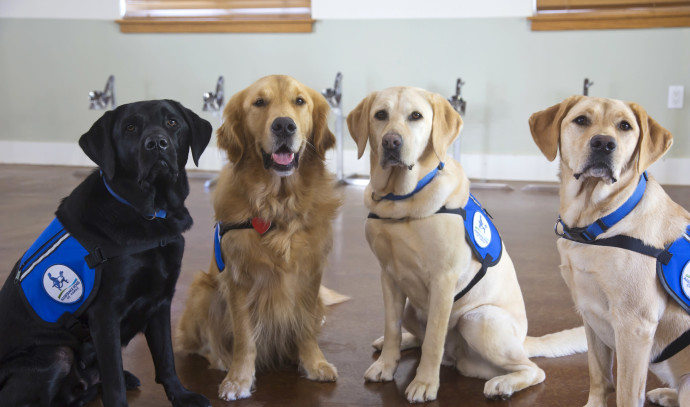Japanese researchers who asked medical staff at a large pediatric hospital about their experiences with full-time “hospital facility” dogs have found that they can provide exceptionally valuable support to the terminally ill and other patients of all ages.
Such dogs can provide valuable support and help gain patients’ cooperation, according to the new study by Natsuko Murata-Kobayashi of the non-profit organization Shine On! just published in the journal PLOS ONE under the title “Exploring the benefits of full-time hospital facility dogs working with nurse handlers in a children’s hospital.”
Hospital facility dogs (HFDs) are professionally-trained dogs that differ from volunteer therapy dogs in their training and work capacity; they are typically cared for by medical professionals and go to work each day. In Japan, the first HFD team started working at the pediatrics hospital in 2010;
Asked by The Jerusalem Post, which sent the study to the directors-general of several Israel hospitals, if they would consider adopting such a project, Shaare Zedek Medical Center’s Prof. Ofer Merin responded immediately that “I’m interested in incorporating the idea!”
The spokeswoman of Hadassah-University Medical Center in Jerusalem Ein Kerem said it has “several programs that use therapy dogs professionally. In the pediatric hemato-oncology department, a new therapy dog program has started that is accompanied by researchers in collaboration with the children’s school staff and the department’s director.
Dr. Tamar Perri, head of the gynecological oncology department at Hadassah added that many of her patients who were diagnosed with cancer have adopted dogs to be with them during their treatment and that the pets calm them and that research is being conducted on the benefits.
Therapy dogs have been used for five years in the child and adolescent psychiatry department through the children’s school, and care for hospitalized children and youth as well as children in day hospitalization, and now in the pediatric intensive care unit, a large project will be introduced to use therapy dogs.”
The spokeswoman of Haifa’s Rambam Healthcare Campus commented that “from time to time, we allow pets to visit terminal patients at the hospital so that they could say goodbye.” As for full-time facility dogs, the hospital will look into the matter, she added.
Having full-time facility dogs in hospitals here could be complicated because many Israeli haredi (ultra-Orthodox) Jews are not used to canines and may even regard them as repulsive, even though the forefathers of Judaism who had large flocks of sheep and goats undoubtedly used dogs to gather the animals and protect them from predators.
Observant Muslims say the Koran regards it as “haram” (forbidden by Islamic law) to keep a dog except for hunting or farming and prevents them from touching wet dogs (but not cats) as they become “impure” before they pray; in such cases, they must wash hands seven times, including once with earth. Thus, efforts to persuade some Israelis that dogs are man’s best friends – who save lives (even by quickly detecting hypoglycemia), quickly lower owners’ blood pressure and more) would need an educational effort.
In 2019, the Japanese researchers distributed a 20-question survey to all 626 full-time medical staff at the medical center, asking about their experiences with HFDs. Of the staff, 431 responded, and 270 of them had directly observed HFD activities.
THE IMPACT OF HFDs in terminal care was ranked highest among the respondents, but they also increased patient cooperation for clinical procedures, including painful ones. The most profound impacts of HFDs, the researchers said, were observed in terminal care and patient cooperation, with 73% of respondents reporting that HFDs were “very often” or “always” beneficial in providing palliative care during the terminal phase. The same percentage reported that HFDs “very often” or “always” helped them gain the cooperation of a patient. A majority of respondents also said that HFDs improved their workload and helped children who had difficulty with schedule changes. They further observed that children became more expressive and communicative following HFD interventions.
More medical professional serving as hospital facility dogs
In recent years, an increasing number of medical professionals have been serving as HFD handlers, including clinical psychologists, child life specialists, occupational therapists and physical therapists, they wrote. “The program investigated in this study is unique as it employed nurses as handlers and operated on a full-time basis. The use of conventional therapy dogs has spread because of their low cost derived from volunteer services. Compared to volunteer therapy dog programs, there are higher costs associated with launching and implementing an HFD team in a pediatric hospital. In the case of our program, in addition to the labor cost of the nurses who serve as handlers, there is the cost of training an HFD to service dog standards.”
In the US, training a service dog is estimated to cost $10,000. “Given the significant financial investment, it’s important to examine the impact and value of the HFD team’s activities. Additionally, animal welfare must be addressed through the creation of a system to optimize and prioritize the working time and activities of an HFD team. Most hospitals in Japan have only one HFD team, even large hospitals with hundreds of beds, making it impossible for all pediatric patients to receive support,” they wrote.
“In previous studies of volunteer therapy dog activities, various patient changes have been reported after a single intervention of about 20 minutes. In contrast, interventions by medical professional handlers have been reported to be positive, but these interventions were conducted on a short-term basis in comparison with our full-time HFDs and medical professional handlers. No previous studies have extensively examined the effectiveness of different types of interventions under the following set of conditions – the handler is a medical professional, the dog is an HFD, and both the handler and HFD work full time.”
The authors concluded that a full-time model with HFDs and nurse handlers offers several significant benefits for supporting patients in children’s hospitals. However, they note that more work is needed to study and optimize the effectiveness of specific HFD interventions. “Through accumulating evidence from research, we aim to contribute to the broader adoption of facility dogs in children’s hospitals both domestically and internationally.”



